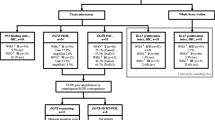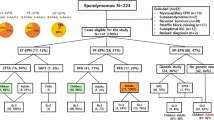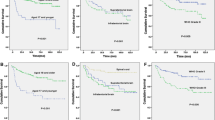Abstract
To determine whether Ki-67 (MIB-1) and p53 have prognostic value in ependymomas, clinicopathologic study was undertaken in 29 patients with this tumor. The clinical course correlated well with the histological grade according to the World Health Organization (WHO) grading system, and it was the worst in patients with anaplastic ependymoma. The percent expression of MIB-1 and p53 correlated with the histological grade of malignancy. With regard to the subtypes of benign ependymoma, the clinical course was the worst in clear-cell ependymoma, which had a significantly higher expression of MIB-1 and p53 than the other subtypes. Tanycytic ependymoma showed the most benign clinical course and the lowest expression of MIB-1 and p53. Although the WHO grading generally tended to correlate with the clinical course of ependymomas, these two subtypes-clear-cell ependymoma and tanycytic ependymoma-exhibited biological properties different from those of other grade II ependymomas.
Similar content being viewed by others
References
Kleihues P, Cavenee WK (2000) Pathology and genetics tumor of the nervous system. International Agency for Research on Cancer (IARC), Lyon, pp 72–77
Schiffer D, Chio A, Giordana MT, et al (1991) Histologic prognostic factors in ependymoma. Child's Nerv Syst 7:177–182
Ernestus RI, Schroder R, Stutzer H, et al (1997) The clinical and prognostic relevance of grading in intracranial ependymomas. Br J Neurosurg 11:421–428
Min KW, Scheithauer BW (1997) Clear cell ependymoma: a mimic of oligodendroglioma: clinicopathological and ultrastructural considerations. Am J Surg Pathol 21:820–826
Kleihues P, Burger PC (1993) Histological typing of tumors of the central nervous system. Springer-Verlag, Berlin, pp 17–18
Kawano N, Yada K, Yagishita S (1989) Clear cell ependymoma: a histologic variant with diagnostic implications. Pathol Anat histopathol 415:467–472
Kawano N, Yagishita S, Komatsu K, et al (1999) Cerebellar clear cell ependymoma mimicking hemangioblastoma; its clinical and pathological features. Surg Neurol 51:281–288
Kawano N, Yada K, Suwa T, et al (1989) Oligodendroglioma-like cell in ependymoma. Acta Neuropathol (Berl) 62:141–144
Takakusaki H, Akimoto J, Ohiwa Y, et al (1999) One case of clear cell ependymoma. Neurooncology 9:93–95
Kakita A, Takahashi H, Fusejima T, et al (1995) Clear cell variants of intracranial tumors: meningioma and ependymoma. Brain Tumor Pathol 12:111–116
Friede RL, Pollak A (1978) The cytogenetic basis for classifying ependymomas. J Neuropathol Exp Neurol 37:103–118
Prayson RA (1999) Clinicopathological study of 61 patients with ependymoma including MIB-1 immunohistochemistry. Ann Diagn Pathol 3:11–18
Langofrd LA, Barre GM (1997) Tanycytic ependymoma. Ultrastruct Pathol 21:135–142
Hayashi S, Kameyama S, Fukuda M, et al (2000) Ganglioma with a tanycytic ependymoma as the glial component. Acta Neuropathol (Berl) 99:310–316
Daneyemez M, Can C, Izci Y, et al (1999) The tanycytic ependymoma of the lateral ventricle: case report. Minim Invas Neurosurg 42:20–23
Kawano N, Yagishita S, Oka H, et al (2004) Spinal tanycytic ependymomas: case reports. Acta Neuropathol (Berl) (in press)
Ritter AM, Hess KR, McLendon RE, et al (1998) Ependymoma: MIB-1 proliferation index and survival. J Neurooncol 40:51–57
Schroder R, Ploner C, Ernestus RI (1993) The growth potential of ependymomas with varying grades of malignancy measured by the Ki-67 labelling and mitotic index. Neurosurg Rev 16:145–150
Karamitopoulou E, Perentes E, Diamantis I, et al (1994) Ki-67 immunoreactivity in human central nervous system tumors: a study with MIB-1 monoclonal antibody on archival material. Acta Neuropathol (Berl) 87:47–54
Louis DN, Edgerton S, Thor AD, et al (1991) Proliferation cell nuclear antigen and Ki-67 immunohistochemistry in brain tumors: a comparative study. Acta Neuropathol (Berl) 81:675–679
Schroder R, Ploner C, Ernestus RI (1993) The growth potential of ependymomas with varying grades of malignancy measured by the Ki-67 labelling and mitotic index. Neurosurg Rev 16:145–150
Sidransky D, Mikkelsen T, Schwechheimer K, et al (1992) Clonal expansion of p53 mutant cells is associated with brain tumor progression. Nature 355:846–847
Tominaga T, Katayama T, Kumabe T, et al (1995) Anaplastic ependymoma: clinical features and tumor suppressor gene p53 analysis. Acta Neurochir (Wien) 135:163–170
Fink KL, Rushing EJ, Scholf SC Jr, et al (1996) Infrequency of p53 gene mutations in ependymomas. J Neurooncol 27:111–115
Metzger AK, Scheffield VC, Duyk G, et al (1991) Identification of a germ-line mutation in the p53 gene in a patient with an intracranial ependymoma. Proc Natl Acad Sci USA 88:7825–7829
Nozaki M, Tada M, Matsumoto R, et al (1998) Rare occurrence of inactivating p53 gene mutation in primary non-astrocytic tumors of the central nervous system: reappraisal by yeast functional assay. Acta Neuropathol (Berl) 95:291–296
Author information
Authors and Affiliations
Rights and permissions
About this article
Cite this article
Suzuki, S., Oka, H., Kawano, N. et al. Prognostic value of Ki-67 (MIB-1) and p53 in ependymomas. Brain Tumor Pathol 18, 151–154 (2001). https://doi.org/10.1007/BF02479429
Received:
Accepted:
Issue Date:
DOI: https://doi.org/10.1007/BF02479429




